A handful of rice yields high hopes
“Building Climate-Resilient and Eco-friendly Agriculture Systems and Livelihoods” (Climate REAL) is a project implemented by the Food and Agriculture Organization of the United Nations (FAO) with financial support from Korea International Cooperation Agency (KOICA) as part of KOICA’s Integrated Programme for Climate Resilience and Empowerment in Attapeu Province, Lao People’s Democratic Republic.
Five beneficiaries share the positive changes experienced from participating in the project.
As the newly harvested rice is being processed in the rice sorter, Khammoun Heuangsouvantha remarks on the noticeable change in the quality and quantity of the rice he can produce. The 58-year-old has been farming rice all his life – starting at a young age helping his parents in the fields – but this is the first season that he has seen such good yields.
For decades, Khammoun had only experienced low yields, and providing for his family of six had become increasingly more difficult. Crop production was affected by multiple factors including threats imposed by climate change, natural disasters, pests and diseases. Farmers in the community had few resources or strategies to respond to these problems and relied on traditional practices.

Khammoun checked his rice from the rice sorter provided by the Climate REAL project.
© FAO/Bounmee Maokhamphio
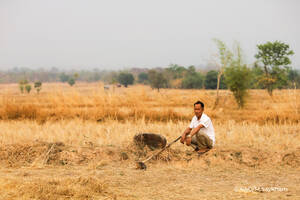
Khammoun went to his rice field with his hoe.
© FAO/Saykham Manilasith
“With all the effort I put in, I only ever got low output. If I put in less effort, I got even lower yields.”
February 2023 was the start of a new venture for Khammoun. Because of his passion for rice farming and enthusiasm for new knowledge and skills to improve crop production, he was nominated by local government authorities to participate in the Climate REAL project activities. Initial engagement with the project included weekly trainings of season-long Farmer Field School on rice seed production and study visits to well-established and successful farmers in Savannakhet and Champasak Provinces.
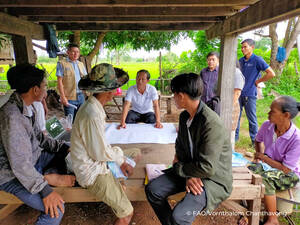
Village consultation activities to gather information under the Climate REAL project.
© FAO/Vornthalom Chanthavong
Khammoun learned quickly and was able to remember by heart the ingredients and proportions of botanical pesticides from locally available materials and specific techniques for rice planting procedures as well as pest and disease management. He could also provide the rationale behind the techniques.
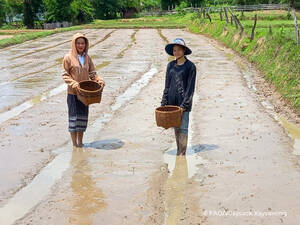
Villagers of Attapeu Province are preparing to grow rice.
© FAO/Vilaysack Xayyavong
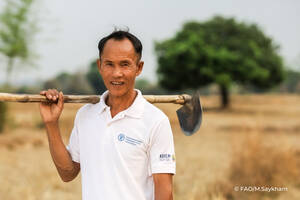
Khammoun went to his rice field with his hoe.
© FAO/Saykham Manilasith
“I admit that I did not know about which fertilizer was for rice crops, the role of fertilizer for rice at each growth stage, which formula to use when and by how much in relation to the rice growth stage and size of paddy field until I joined the project. Now, I know that each formula contains different nutrient needs for rice crop development at each growth stage. Through learning by doing, l also learned that the level of fertilizer application depends on the rice growth stage and size of the rice field as well as soil fertility.”
From joining the project, Khammoun now knows how to deal with, prevent and manage rice insects and disease such as planthoppers and seed-borne disease. He also fully recognizes how much the proper application of fertilizer contributes to the rice yield.
One of the most significant lessons was the importance of seed selection to improve the quality of the yields. Techniques on seed selection need to be performed every rice planting season to reduce any potential seed-borne diseases, which can cause severe problems in the rice cultivation process.

Photo of the rice field in the implementation area of the Climate REAL project.
© FAO/Vornthalom Chanthavong
Within a few months, Khammoun was able to put his learning into practice with good results. He received 9kg of RD2 rice seeds from the project to produce RD3 rice seeds in the rainy/rice-growing season from June to November 2023 and decided to conduct an experiment. He would compare the results of using traditional practices and project intervention techniques with the rice seeds given by the project against his own. He applied what he had learned in the Farmer Field School on RD3 rice seed production, and used traditional practices as a control field. He observed a big difference between the two. He was delighted to report that rice grown with techniques and quality seeds introduced by the project produced bigger and greener leaves and plumper rice ears.
Not only was the quality better, but the project intervention techniques also resulted in greater volume. The 9kg of RD2 rice seeds from a reliable source produced 480 kg of RD3 rice seeds which, at LAK 12 000 per kilo, could sell for approximately LAK 6 million. Conversely, his own traditional rice variety and technique yielded lower outputs and could only fetch a price of LAK 7 000 per kilo.
This is the first time that Khammoun has been involved with projects such as Climate REAL and, while initial investments were high, the results have been amazing. He and others in farmer groups in the area are grateful to the project for investing in the rice sorting machine, which reduces the cost of processing the quality rice seed with potential market access. This initial investment gave direct beneficiaries the confidence to financially engage with project activities and also showed the potential for their own investment in the future.
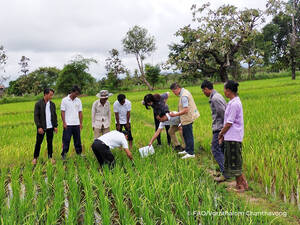
Villagers in the target area of the Climate REAL project and the project staff inspected the quality of rice planting
© FAO/Vornthalom Chanthavong
Because of his great results, Khammoun has been invited to join many workshops, meetings and events. He has gone on to share his knowledge with his family and the wider community, including local farmers who have not yet participated in the project directly and with other target districts of the project.
Hopes are high for the rice farming communities of Attapeu Province. Apart from planning and preparing for the next rice growing season, Khammoun has also started to make plans for his grandson’s future. He personally believes that there is no end to the learning and enrichment and that local farmers can benefit from continued support. It is hoped that in the next 5 to 10 years, villagers will be able to produce enough rice not only for their own families but also for sale. The potential to start a small agribusiness and gradually improve living conditions would be within reach.
Download this story
[English] [Lao]
